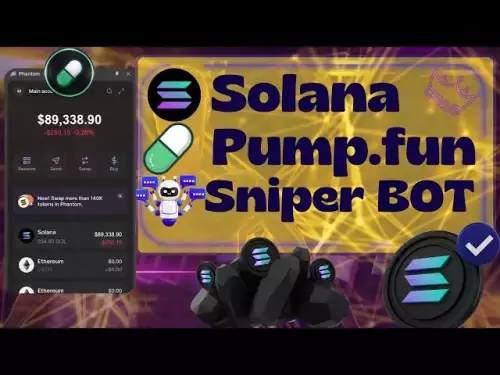-
 Bitcoin
Bitcoin $115100
-1.30% -
 Ethereum
Ethereum $4758
-1.70% -
 XRP
XRP $3.027
-2.19% -
 Tether USDt
Tether USDt $0.9998
-0.01% -
 BNB
BNB $883.2
-1.42% -
 Solana
Solana $204.0
2.62% -
 USDC
USDC $1.000
0.02% -
 Dogecoin
Dogecoin $0.2371
-0.97% -
 TRON
TRON $0.3612
-1.24% -
 Cardano
Cardano $0.9128
-2.19% -
 Chainlink
Chainlink $26.13
-3.93% -
 Hyperliquid
Hyperliquid $44.73
0.90% -
 Sui
Sui $3.715
-0.56% -
 Stellar
Stellar $0.4153
-2.41% -
 Ethena USDe
Ethena USDe $1.000
-0.04% -
 Bitcoin Cash
Bitcoin Cash $588.9
-2.06% -
 Avalanche
Avalanche $25.91
3.27% -
 Hedera
Hedera $0.2525
-1.45% -
 Litecoin
Litecoin $120.9
-1.35% -
 UNUS SED LEO
UNUS SED LEO $9.607
0.30% -
 Toncoin
Toncoin $3.382
-0.31% -
 Shiba Inu
Shiba Inu $0.00001329
-0.38% -
 Uniswap
Uniswap $11.38
-1.67% -
 Polkadot
Polkadot $4.222
2.83% -
 Aave
Aave $354.5
4.93% -
 Dai
Dai $0.0000
0.00% -
 Bitget Token
Bitget Token $4.704
-1.49% -
 Cronos
Cronos $0.1565
1.83% -
 Ethena
Ethena $0.7463
1.55% -
 Monero
Monero $265.8
-0.39%
How to trade WMA crossovers with different period lengths?
The Weighted Moving Average (WMA) emphasizes recent prices, making it more responsive than SMA and ideal for spotting trends in fast-moving crypto markets.
Aug 13, 2025 at 11:35 am

Understanding the Weighted Moving Average (WMA)
The Weighted Moving Average (WMA) is a technical indicator that assigns greater importance to recent price data, making it more responsive to new information compared to the Simple Moving Average (SMA). This responsiveness makes WMA particularly useful in identifying trend direction and potential reversal points in cryptocurrency markets. The calculation of WMA involves multiplying each price point in the data set by a weighting factor, with the most recent prices receiving higher weights. For example, in a 5-period WMA, the most recent closing price is multiplied by 5, the previous by 4, and so on, down to 1. These weighted values are then summed and divided by the sum of the weights (in this case, 1+2+3+4+5 = 15).
Traders use WMA to smooth out price volatility and generate clearer signals. Because of its emphasis on recent prices, the WMA tends to hug the price action more closely than SMA, reducing lag. This characteristic is especially valuable in fast-moving crypto markets where delays in signal generation can lead to missed opportunities or increased risk.
Setting Up WMA Crossover Strategies
A WMA crossover strategy involves using two WMA lines with different period lengths on a price chart. The shorter-period WMA reacts more quickly to price changes, while the longer-period WMA provides a broader trend context. When the shorter WMA crosses above the longer WMA, it generates a bullish crossover signal, suggesting upward momentum. Conversely, when the shorter WMA crosses below the longer one, it indicates a bearish crossover, signaling potential downward movement.
To set this up on a trading platform like TradingView or MetaTrader:
- Open the chart of the cryptocurrency you want to trade (e.g., BTC/USDT).
- Apply the WMA indicator twice.
- Configure the first WMA with a shorter period, such as 9.
- Configure the second WMA with a longer period, such as 21.
- Assign different colors to each line for clarity (e.g., green for 9-period, red for 21-period).
- Observe the interaction between the two lines for crossover events.
The choice of period lengths depends on your trading style. Shorter periods like 5 and 10 are suitable for scalping, while combinations like 21 and 50 may be better for swing trading.
Choosing Optimal Period Lengths for Crypto Trading
Selecting the right period lengths is crucial for effective WMA crossover trading. Cryptocurrencies exhibit high volatility and rapid trend shifts, so overly long periods may produce delayed signals, while overly short ones may generate false alarms.
Common effective combinations include:
- 5 and 13: Ideal for intraday trading on 5-minute or 15-minute charts. This setup captures short-term momentum shifts.
- 9 and 21: A balanced choice for 1-hour charts, often used in day trading.
- 21 and 55: Suitable for daily charts, helping identify medium-term trends in assets like Ethereum or Solana.
To test these combinations:
- Backtest on historical data using a platform that supports strategy testing.
- Use paper trading to validate performance in real-time without financial risk.
- Adjust based on the asset’s average volatility—Bitcoin may require longer periods than altcoins due to its relative stability.
The 21-period WMA is especially popular because it approximates a trading month (21 days), aligning with institutional trading cycles.
Executing Trades Based on WMA Crossovers
When a WMA crossover occurs, the next step is to execute a trade with proper risk management. Here’s how to proceed:
- Confirm the crossover on your chosen timeframe (e.g., 1-hour chart).
- Check higher timeframes (e.g., 4-hour or daily) to ensure alignment with the broader trend.
- Wait for the candle to close fully after the crossover to avoid false signals from intra-candle noise.
- Enter a long position when the short WMA crosses above the long WMA.
- Enter a short position when the short WMA crosses below the long WMA.
- Place a stop-loss just below the recent swing low (for longs) or above the swing high (for shorts).
- Set a take-profit level using a risk-reward ratio of at least 1:2.
For example, if trading ETH/USDT on a 1-hour chart with a 9/21 WMA crossover:
- A bullish crossover appears.
- The price is above the 200-period WMA on the 4-hour chart, confirming an uptrend.
- You enter a long at the close of the candle.
- Your stop-loss is set 2% below entry.
- Your take-profit is set 4% above entry.
This method combines trend confirmation with precise entry timing.
Filtering False Signals in WMA Crossover Systems
WMA crossovers can produce false signals, especially in sideways or choppy markets. To reduce noise:
- Use volume filters: Only take crossovers that occur with above-average trading volume, indicating stronger conviction.
- Add a trend filter: Only trade crossovers in the direction of the higher timeframe trend.
- Combine with support and resistance levels: A bullish crossover near a known support zone increases its reliability.
- Use price action confirmation: Look for bullish candlestick patterns (e.g., engulfing, hammer) after a bullish crossover.
For instance, if the 9-period WMA crosses above the 21-period WMA but the price is near a strong resistance level, it may be wise to avoid the trade. Conversely, the same crossover near a breakout point from a consolidation pattern carries higher validity.
Another effective filter is the Average Directional Index (ADX). When ADX is above 25, the market is trending, making WMA crossovers more reliable. Below 20, the market is likely ranging, and crossovers should be treated with caution.
Monitoring and Adjusting WMA Parameters
Market conditions evolve, so period lengths that work today may become less effective tomorrow. Regular monitoring is essential:
- Review trade performance weekly using a trading journal.
- Track win rate and average profit/loss per trade.
- If win rate drops below 50% over 20 trades, consider adjusting the WMA periods.
- Test new combinations in a demo account before live implementation.
- Consider adaptive WMA settings that change based on volatility (e.g., using ATR to modify periods).
Some traders use dynamic period selection, where the shorter WMA is set to one-third of the longer WMA (e.g., 10 and 30, 15 and 45). This maintains a consistent ratio that can adapt across different assets.
FAQs
What is the best timeframe to use WMA crossovers for crypto trading?
The 1-hour and 4-hour charts are widely used because they balance signal reliability and trade frequency. Lower timeframes like 5-minute generate too many false signals, while daily charts may miss short-term opportunities.
Can WMA crossovers be used for all cryptocurrencies?
Yes, but effectiveness varies. Major coins like Bitcoin and Ethereum respond better due to higher liquidity and trend persistence. Low-cap altcoins with erratic price action may produce unreliable signals.
How do I know if a WMA crossover is valid?
A valid crossover occurs when the shorter WMA clearly crosses and closes beyond the longer WMA, supported by increasing volume and alignment with the higher timeframe trend. Absence of these factors suggests a potential false signal.
Should I use WMA crossovers alone or with other indicators?
WMA crossovers are more effective when combined with volume, trend filters, or oscillators like RSI. Using them in isolation increases the risk of acting on misleading signals, especially in volatile crypto markets.
Disclaimer:info@kdj.com
The information provided is not trading advice. kdj.com does not assume any responsibility for any investments made based on the information provided in this article. Cryptocurrencies are highly volatile and it is highly recommended that you invest with caution after thorough research!
If you believe that the content used on this website infringes your copyright, please contact us immediately (info@kdj.com) and we will delete it promptly.
- XYZVerse, Shiba Inu, and the 2025 Bull Cycle: A Meme Coin Evolution
- 2025-08-24 13:05:12
- WLFI Token, BingX, and the Trading Landscape: A New York Perspective
- 2025-08-24 12:45:20
- Aave, Governance, Allocation: Navigating DeFi's Shifting Sands
- 2025-08-24 12:45:20
- Crypto Coins in 2025: Meme Coins, Undervalued Blockchains, and Bull Run Predictions
- 2025-08-24 13:05:12
- Fed Pivot Ignites Crypto Rally: Altcoins Set to Outperform?
- 2025-08-24 13:25:12
- Eric Trump, Tokyo, and Metaplanet: A Bitcoin Bonanza?
- 2025-08-24 11:05:13
Related knowledge

What does it mean when the +DI and -DI cross frequently in the DMI indicator but the ADX is flattening?
Aug 11,2025 at 03:15am
Understanding the DMI Indicator ComponentsThe Directional Movement Index (DMI) is a technical analysis tool composed of three lines: the +DI (Positive...

What does the sudden appearance of a "dark cloud cover" candlestick pattern during an uptrend indicate?
Aug 13,2025 at 11:35am
Understanding the 'Dark Cloud Cover' Candlestick PatternThe dark cloud cover is a bearish reversal pattern in technical analysis that typically appear...

What does it mean when the moving average, MACD, and RSI all send buy signals simultaneously?
Aug 11,2025 at 01:42pm
Understanding the Convergence of Technical IndicatorsWhen the moving average, MACD, and RSI all generate buy signals at the same time, traders interpr...

What does it mean when both the KDJ indicator and the RSI show overbought signals simultaneously?
Aug 13,2025 at 11:35am
Understanding the KDJ Indicator in Cryptocurrency TradingThe KDJ indicator is a momentum oscillator derived from the Stochastic Oscillator, widely use...

What does it mean when the price is trading above the SAR indicator but the red dots are densely packed?
Aug 09,2025 at 11:49pm
Understanding the SAR Indicator and Its Visual SignalsThe SAR (Parabolic Stop and Reverse) indicator is a technical analysis tool used primarily to de...

What does it mean when the candlestick chart forms a "Morning Star" but trading volume is sluggish?
Aug 12,2025 at 06:28pm
Understanding the Morning Star Candlestick PatternThe Morning Star is a three-candle bullish reversal pattern commonly observed in cryptocurrency pric...

What does it mean when the +DI and -DI cross frequently in the DMI indicator but the ADX is flattening?
Aug 11,2025 at 03:15am
Understanding the DMI Indicator ComponentsThe Directional Movement Index (DMI) is a technical analysis tool composed of three lines: the +DI (Positive...

What does the sudden appearance of a "dark cloud cover" candlestick pattern during an uptrend indicate?
Aug 13,2025 at 11:35am
Understanding the 'Dark Cloud Cover' Candlestick PatternThe dark cloud cover is a bearish reversal pattern in technical analysis that typically appear...

What does it mean when the moving average, MACD, and RSI all send buy signals simultaneously?
Aug 11,2025 at 01:42pm
Understanding the Convergence of Technical IndicatorsWhen the moving average, MACD, and RSI all generate buy signals at the same time, traders interpr...

What does it mean when both the KDJ indicator and the RSI show overbought signals simultaneously?
Aug 13,2025 at 11:35am
Understanding the KDJ Indicator in Cryptocurrency TradingThe KDJ indicator is a momentum oscillator derived from the Stochastic Oscillator, widely use...

What does it mean when the price is trading above the SAR indicator but the red dots are densely packed?
Aug 09,2025 at 11:49pm
Understanding the SAR Indicator and Its Visual SignalsThe SAR (Parabolic Stop and Reverse) indicator is a technical analysis tool used primarily to de...

What does it mean when the candlestick chart forms a "Morning Star" but trading volume is sluggish?
Aug 12,2025 at 06:28pm
Understanding the Morning Star Candlestick PatternThe Morning Star is a three-candle bullish reversal pattern commonly observed in cryptocurrency pric...
See all articles

























































































